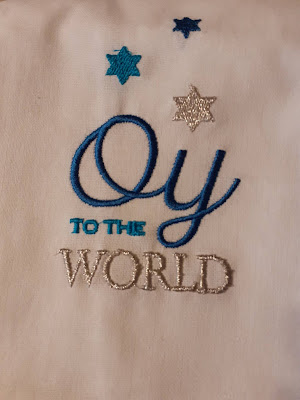Chanukah Charlie returns to explain Hanukkah
The eight-day Jewish Festival of Lights began Sunday night, with today (Monday,
Nov. 29) being the first day of the holiday. Over the years, stretching back
more than two decades, of working for The Sun Chronicle, I’d write versions of
this column to explain the holiday to those who aren’t familiar with its history and purpose.
Here’s the
2021 version of my Chanukah Charlie column:
This column was published in the Nov. 27-28, 2021
Weekend edition of The Sun Chronicle of Attleboro, MA (LINK to column on Sun Chronicle website: https://www.thesunchronicle.com/opinion/columns/kessler-brush-up-on-your-hanukkah-knowledge-with-chanukah-charlie/article_308bd8bb-e275-57cf-84b2-3ac347465b0b.html
For the first time since 2013, when the first night of Hanukkah, the eight-day Jewish Festival of Lights, began the night before Thanksgiving, the holiday will once again start close to Turkey Day.
That’s right: the first of eight candles will be lit Sunday night, with the last one to be illuminated Sunday evening Dec. 5. The last time that happened, Madison Avenue hijacked the holiday, inelegantly dubbing it “Thanksgivukkha” to call attention to Hanukkah coinciding with Thanksgiving.
While that’s been rare, it’s routine for Hanukkah to fall at different times in relation to the everyday calendar. Next year, for instance, Hanukkah will overlap with Christmas, as the first day will be Monday, Dec. 19, 2022, with the first candle to be lit the night before, and the final one on Christmas night.
Exactly why the dates fluctuate so sharply is just one of the many facts about Hanukkah that my good friend, Chanukah Charlie, started explaining to Sun Chronicle readers many years ago to teach people about the often-misunderstood winter holiday, which over the years has erroneously been referred to as the “Jewish Christmas.”
Charlie and I revived the column last year, and we’re pleased to bring it back to foster understanding among cultures and religions, something that’s urgently needed amid reports by the Anti-Defamation League that anti-Semitic incidents are dramatically on the rise in the United States and globally.
So, take a break from Black Friday weekend shopping and try Charlie’s open-book quiz. We hope it will both enlighten and amuse you during a grim period of American history where hatred and extremism too often have replaced empathy and compassion.
1. Hanukkah is celebrated because:
A. Bubbies (grandmothers) needed another reason to make potato pancakes called “latkes.”
B. A victory in 164 BCE (Before the Common Era, which is how Judaism refers to 164 BC) by rebels over a bigger army preserved Judaism from extinction.
C. Retailers wanted one more reason to sell stuff.
Answer: B.
2. On Hanukkah, we light:
A. 20-foot-tall dreidels.
B. Hanukkah bushes.
C. A candelabra called a menorah.
Answer: C.
3. Judah commanded the force that beat the Syrian Greeks. They were called:
A. The Maccabees.
B. The Running Rebels.
C. The Keep the Faith Brigade.
Answer: A.
4. How long did it take the Maccabees to win and re-enter the temple after the Syrian Greeks desecrated it?
A. A lot less time than the Massachusetts Statehouse has been closed to the public.
B. Quicker than a baseball playoff game.
C. Three years.
Answer: C
5. The king of the Syrian Greeks was:
A. Alexander the Great.
B. Antiochus IV.
C. Zorba VI.
Answer: B.
6. Antiochus forbid the Jewish people from:
A. Eating kosher food and praying.
B. Teaching and practicing Judaism and studying the Torah (the five books of Moses of the Old Testament).
C. All of the above.
Answer: C.
7. The miracle of Chanukah is that:
A. One day of oil kept the menorah lit eight days.
B. The temple was rededicated. (Chanukah means dedication.)
C. Supply-chain woes didn’t affect latke production.
Answer: A.
8. How do you put the candles in the menorah? (A new candle, along with the “shamus” or server candle, is added each night.)
A. Light them quickly so you can exchange gifts.
B. Right to left, and light them left to right so the oldest candle is put in first and the newest is lit first.
C. Same as B, only reversing the right and left.
Answer: B.
9. What’s a dreidel?
A. A toy used in a game that doesn’t involve an APP.
B. A utensil to make latkes.
C. A spinning top with Hebrew letters.
Answer: C.
10. The dreidel game is played:
A. On any solid surface in your home.
B. Before and after lighting the candles.
C. While waiting for the latkes to cool off.
Answer: Bet on all of them.
11. In the game, the winner gets the pot (usually pennies or chocolate coins called “gelt”) if the dreidel:
A. Lands on the Hebrew letter “gimel.”
B. Lands on the Hebrew letter “hay.”
C. Flies off the table and into a boiling pot of chicken soup.
Answer: A.
12. Which English spelling of the holiday is acceptable?
A. C—h—a—n—u—k—a—h.
B. H—a—n—u—k—a—h.
C. H—a—n—u—k—k—a—h.
Answer: All of them because the English is transliterated from the Hebrew. C is the most common spelling.
BONUS FACT 1 — True or false: Hanukkah falls on the same day every year.
Answer: True; it falls on the 25th day of the Hebrew month of Kislev.
BONUS FACT 2 — Hanukkah’s date changes yearly in relation to the common calendar because the Hebrew calendar is a lunar one that loses time. To compensate, a leap year with a 13th month in the mid-winter, called Adar II, is added every few years.
Larry Kessler is a retired Sun Chronicle local news editor and can be reached at larrythek65@gmail.com. He blogs at larrytheklineup.blogspot.com

Comments
Post a Comment